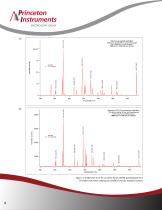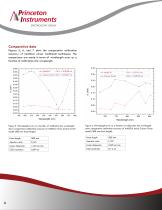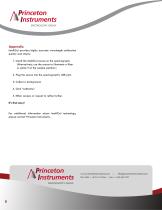
Catalog excerpts

Technical Note SPECTROSCOPY GROUP Fully automated wavelength calibration method optimizes data accuracy An intelligent new routine The recent launch of Princeton Instruments’ ™ powerful LightField 64-bit data acquisition software also heralded the arrival of a brand new, fully automated wavelength calibration method developed to achieve unprecedented accuracy for spectroscopy applications (see Figures 1–4). Currently offered as a LightField package option, patent-pending IntelliCal™ technology from Princeton Instruments enables fast, reliable wavelength calibration with minimal user input (see Appendix). In essence, IntelliCal is a full-spectrum calibration routine that refines a theoretical spectrograph model based on the physical properties of the actual instrument being utilized. This technical note will first provide a review of critical problems inherent to traditional calibration techniques and then present basic IntelliCal theory, comparative data, and key implications of the new method. The development of IntelliCal was fueled by the desire to surmount several shortcomings associated with traditional wavelength calibration methods, especially overreliance on user input for accuracy. By and large, the post-calibration wavelength accuracy is not known by the software programs utilized in these traditional routines, so its determination is left up to the user. Figure 1. IntelliCal source installed on an Acton Series SP2300 spectrograph from Princeton Instruments. Using a source with multiple known emission lines to illuminate the entrance slit of the spectrograph, it is possible to determine a direct wavelength-to-detector pixel coordinate correlation. There are two common types of wavelength space calibration: (1) a polynomial fit where only two or three emission lines are used and (2) a fit to the Czerny-Turner model. Some routines utilize a polynomial fit to define the spectral dispersion across the focal plane and thus obtain calibration results at the pixel level. This technique, in which a polynomial is fit to a plurality of known emission lines, is both the more accurate and more tedious of the aforementioned methods. The user must not only determine which emission lines are seen by the detector, but must redo the calibration each time the grating is moved. Furthermore, the accuracy of this © 2011 Princeton Instruments, Inc. All rights reserved.
Open the catalog to page 1
SPECTROSCOPY GROUP approach is partially limited by the number of lines used to generate the fit; typically, only two or three observed spectral emission lines are used. The most commonly utilized wavelength space calibration is a fit to the Czerny-Turner model. Here, the user is prompted to select a known emission line and the grating is moved so as to position the selected line at two or more locations across the CCD. The grating is then moved to a different line. This process is repeated at least once. Next, the wavelength space residual is defined and minimized with respect to the...
Open the catalog to page 2
SPECTROSCOPY GROUP step size IntelliCal fixed wavelength calibration 150 gr/mm grating, 300 mm spectrograph Hg and Ar lines from IntelliCal source RMS error = 0.120 nm over 12 lines step size Standard wavelength calibration 150 gr/mm grating, 300 mm spectrograph Hg and Ar lines from IntelliCal source 253 and 1014 nm lines used in 2-point calibration RMS error over 12 lines = 1.05 nm Figure 3. Calibration error for an Acion Series SP2300 specirograph from Princeton Insirumenis utilizing (a) InielliCal and (b) siandard routines. The relatively high RMS calibration error is due io the low...
Open the catalog to page 3
SPECTROSCOPY GROUP IntelliCal wavelength calibration 1200 gr/mm grating, 85 mm lens spectrograph Ne/Ar lines from IntelliCal source RMS error = 0.088 nm over 8 lines step size Standard (HTS Cal) wavelength calibration 1200 gr/mm grating, 85 mm lens spectrograph Ne/Ar lines from IntelliCal source RMS error = 0.184 nm over 8 lines step size Figure 4. Calibration error for an Acion Series LS785 spectrograph from Princeion Insirumenis utilizing (a) InielliCal and (h) siandard routines.
Open the catalog to page 4
SPECTROSCOPY GROUP Basic theory IntelliCal is a fully automated calibration routine in which a non-linear least squares refinement algorithm is derived that minimizes the intensity space residual with respect to a theoretical model of the spectrograph. IntelliCal simulates the entire observed spectrum; the number of observables is always equal to the number of horizontal pixels in the CCD array. No significant user input is required. The ultimate aim of IntelliCal is to minimize the residual difference between observed and calculated emission line spectral intensities. This goal is realized...
Open the catalog to page 5
SPECTROSCOPY GROUP Comparative data Figures 5, 6, and 7 show the comparative calibration accuracy of IntelliCal versus traditional techniques. The comparisons are made in terms of wavelength error as a function of calibration line wavelength. Figure 5. Wavelength error as a function of calibration line wavelength shows comparative calibration accuracy of IntelliCal versus Czerny-Turner model (500 mm focal length). Figure 6. Wavelength error as a function of calibration line wavelength shows comparative calibration accuracy of IntelliCal versus Czerny-Turner model (300 mm focal length)....
Open the catalog to page 6
SPECTROSCOPY GROUP -■- 1 0 Point 3rd Order Polynomial Fit <6X> = 0.522 ran Figure 7. Wavelengih error as a function of calibration line wavelengih shows comparative calibration accuracy of InielliCal versus polynomial fii (lens specirograph). First and foremost, as the name implies, IntelliCal provides truly intelligent calibration. Unlike traditional methods, the software is now aware of the instrument it is calibrating. Furthermore, the fully autonomous IntelliCal routine eliminates user error. Of course, the name of the game is accuracy. By treating every pixel in the detector as an...
Open the catalog to page 7
SPECTROSCOPY GROUP IntelliCal provides highly accurate wavelength calibration quickly and simply: 1. Install the IntelliCal source on the spectrograph. (Alternatively, use the source to illuminate a fiber or place it at the sample position.) 2. Plug the source into the spectrograph’s USB port. 3. Collect a background. 4. Click “calibrate”. 5. Either accept, or repeat to refine further. It’s that easy! For additional information about IntelliCal technology, please contact Princeton Instruments. SPECTROSCOPY GROUP
Open the catalog to page 8All Princeton Instruments Acton catalogs and technical brochures
-
Cosmos-Datasheet
16 Pages
-
PI-MAX4
60 Pages
Archived catalogs
-
PhotonMAX
2 Pages
-
PIXIS-XO Product Flyer
2 Pages
-
2D-OMA V Product Flyer
2 Pages
-
PIXIS Product Flyer
2 Pages













